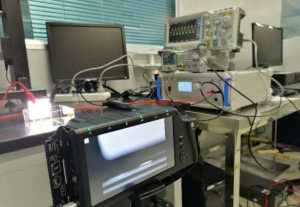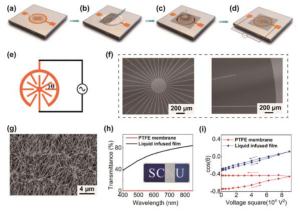Experiment name: Field-induced wettability gradient drives lossless transport of droplets on super lubricated surfaces.
Experimental content: Introducing a field-induced wettability gradient on a flat super lubricated surface. By printing radial arrays of interdigitated electrodes, the electric field can be patterned to create a wettability gradient for directional transport of droplets. Theoretical analysis and experimental results show that the transport behavior of droplets can be evaluated by the dimensionless electric Bond constant, and super lubricated surfaces can transport various types of droplets without damage.
Test purpose: The droplet transport mentioned in the experiment can be applied and developed in aspects such as heat transfer, anti-pollution, microfluidics and biochemical analysis.
Test equipment: electrode substrate, signal generator DG1032, high voltage amplifier SLA-HV-1600S, optical goniometer, optical microscope, PTFE film, high-speed camera
Experiment procedure:

(1) Cover the patterned electrode substrate with a layer of super-lubricating film to prepare the experimental sample ((a-c) in the figure below);
(2) Connect the voltage signals output from the signal generator and high-voltage amplifier to the positive and negative electrodes ((d) in the figure below);
(3) After DC or AC voltage is applied to the electrode substrate, the radial interdigitated design of the electrode can generate an electric field intensity gradient, thereby causing a wettability gradient and realizing droplet transport.

Test Results:
Realize the directional transport of droplets and carry out related applications of directional transport of droplets. Such as the collection of organic micro-droplets (a in the figure below), dust cleaning during droplet transportation (b in the figure below), and transporting droplets in an oil phase environment (c in the figure below).




